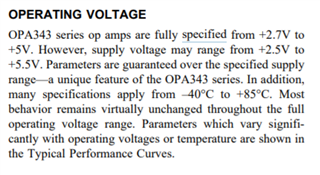As described above, my customer downloaded the opa2343 simulation model from ti.com, and then found that it's not virtual short with single +6v power supply, but it is virtual short under the practical test. And of course, the model is ok with supply voltage under 5.5v. Can you help to explain this?
what's more, can you help me to understand the difference between the Specified Voltage Range and Operating Voltage Range showed on the datasheet.
thanks, and best regards.
Marsh cai



